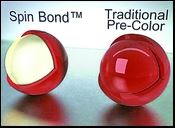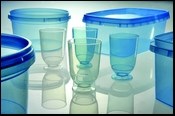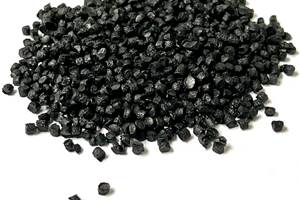What to See at NPE 2006: Materials
Fewer thermoplastic materials suppliers will make the trip to Chicago this year.
Fewer thermoplastic materials suppliers will make the trip to Chicago this year. But even with fewer major resin companies in attendance, there are many new product introductions coming from a strong contingent of compounders and a growing list of overseas suppliers and brokers. Among the new developments are flame-retardant PC/ABS blends made with nanoparticles, extension of plastic-metal “hybrid” technology into all-plastic versions, a new line of PC/polyester alloys from PolyOne, and new anti-static compounds from RTP Co.
Continued intense development efforts in thermoplastic elastomers are evident at NPE 2006 as suppliers unveil several grades that offer new levels of clarity, softness, and overmolding adhesion. Heightened product development activity is also seen in TPUs, where suppliers are focused on new automotive grades that bring softness, light stability, and higher productivity.
Nanoparticles boost performance
Bayer MaterialScience is looking to alumina trihydrate nanoparticles as a way to improve hydrolysis resistance and flame resistance of its Bayblend PC/ABS resins. Bayblend FR 3000 injection molding grades are claimed to be the first FR-PC/ABS blends with nanoparticles. They boast improved processability for thin-wall parts.
Lanxess is extending its plastic/metal hybrid technology by replacing the metal with fabric-reinforced nylon composite sheet developed by Bond-Laminates GmbH in Brilon, Germany. The new all-plastic hybrids are made by first thermoforming the nylon composite sheet. The preform is then preheated, placed in an injection molding tool, and encapsulated with more nylon.
DuPont has four new wear-resistant products. Delrin 100TL acetal with Teflon PTFE micropowder combines high impact strength and elongation with low wear and friction. Delrin 500MP contains PTFE micropowder and a proprietary ingredient. Its stiffness, strength, and toughness are similar to standard medium-viscosity acetals.
For wear-resistant parts that must withstand higher temperatures and more aggressive chemicals, DuPont has unveiled two Zytel HTN high-temperature nylons containing PTFE micropowder: WRF51MP20 and WRF51K20 (which also contains Kevlar aramid fiber).
New PC/PBT and PC/PET alloys from PolyOne are targeted for lawn and garden, recreational, automotive, and business equipment applications. The first 12 Edgetek XT grades include general-purpose, uv-stable, and low-temperature-impact grades.
RTP is showcasing its PermaStat Plus static-dissipative compounds with electrical properties that fall within the so-called “ideal” static-dissipative range of 108 to 109 ohm/sq. The materials also feature static-decay times of less than 0.5 sec and are non-sloughing.
Novel TPEs arrive
Thermoplastic elastomers continue to advance in clarity and softness. One example is Teknor Apex Co.’s new Monprene TPEs, which boast a novel combination of ultra-softness and optical clarity. They can be formulated in hardness from 30 to 60 on the Shore 00 scale, which is comparable to other Monprene Ultra Soft gel products and well below those of conventional TPEs, which are measured on the Shore A scale. Based on hydrogenated styrenic block copolymers, they are FDA-compliant and can be overmolded onto olefinic substrates. Their softness makes them suitable for shoe insoles and heel cups, sporting goods, and other cushioning between hard substrates and personal contact.
PolyOne has developed the OnFlex-S series of TPEs aimed at soft overmolding applications. These are based on new styrenic-block copolymer technology developed jointly with a leading SBC supplier. The K-6200 family is for overmolding onto PC, ABS, and PC alloys and is available in Shore A hardness from 10 to 90. PolyOne is also developing K-6300 nylon-bondable grades in 20 to 90 Shore A.
GLS Corp. has a new clear TPE alloy that is bondable to polar substrates such as PC, ABS, PC/PETG, and PC/PBT. It comes in response to a growing trend in consumer design for clear overmolded TPEs that reveal the rigid substrate. Versaflex OM 3000 series is available in 45 and 60 Shore A.
A novel development in precoloring of TPEs is claimed to be more cost-effective than conventional compounding. E-Z Color Corp.’s Spin-Bond technology reportedly imparts no heat history to the TPE and doesn’t affect physical properties or processability while costing 20% to 50% less than compounding. E-Z Color makes color dispersions that are coated onto pellets through a special process. The technology has been used mostly with TPVs in automotive, consumer electronics, and medical applications.
Mitsui Chemicals has launched a non-crosslinked polyolefin elastomer that offers a good balance of flexibility and heat resistance and high elasticity. Notio elastomer is made with metallocene catalyst technology. Its transparency, toughness, and heat and scratch resistance recommend it as a polyolefin modifier or as a primary molding material.
New TPU developments
The emergence of TPUs in appearance parts, particularly in automotive, has resulted in the development of softer, uv-stable materials. An example is BASF’s new Elastollan HPM modified TPUs, which provide softness down to 60 Shore A without a plasticizer (vs. a previous limit of 80A) and colorfastness that meets the stiff requirements of car makers. These TPUs are contenders in soft-touch interior parts such as door handles, steering wheels, and knobs.
BASF has also introduced to the U.S. new aliphatic TPUs for slush-molded instrument panels. These permit low-temperature airbag deployment and seamless instrument-panel design while providing color stability and abrasion and mar resistance. With a growing trend toward seamless IPs, TPUs are positioned against slush-molded PVC and TPO. The aliphatic grades were recently commercialized in Europe on two car platforms.
Spain’s Merquinsa is introducing two new fast-cycling polycaprolactone-based TPUs for automotive applications. Pearlthane D11T85UV is 85 Shore A and offers strong uv resistance. Targeted uses include gearshift knobs and spring insulators. Pearlthane D11T93 (93 Shore A) features good oil and grease resistance, abrasion resistance, and good temperature and hydrolysis performance versus standard polyester TPUs. It is suitable for elastomeric underhood applications. Both Pearlthane grades reportedly provide 10% faster cycling than competitive TPUs.
Among the latest TPV offerings are PolyOne’s polyolefin-based elastomers that reportedly provide improved compression set, chemical resistance, and service temperature. As part of the OnFlex-V series, PolyOne is launching 20 standard products with uv stability, high melt flow, and low coefficient of friction (COF) down to 0.3 compared to 1.0 for typical TPVs. With hardnesses from 45A to 50D, they have won commercial use in Europe and there is strong initial interest in COF grades for auto weatherseals and architectural window seals in North America.
Guangzhou Environmental Optimization Engineering Co. in China is introducing MEP (Modified Earth Plastic), a newly invented “green” TPE made from renewable resources (described as “modified earth”). MEP boasts good elasticity and high strength and scuff resistance. It can replace PUR paving systems for running tracks, sports courts, and playgrounds. It can also replace cork floorboards and synthetic leather in furniture, handbags, and clothes.
News in PP & PET
Basell Polyolefins will introduce new PP resins for frozen-food packaging. These include Pro-fax impact copolymers for opaque, thin-wall injection molding and Clyrell heterophasic impact copolymers, produced with the Catalloy process for clear, thin-wall, thermoforming. The new resins are said to offer enhanced low-temperature impact as well as reduced odor and taste.
Several new grades of Metocene metallocene-based PP with unique performance characteristics are also being launched by Basell for packaging. They boast low haze, excellent gloss, high rigidity, and improved odor and taste.
DAK Americas will announce details on Laser+ PET container resins. They will be commercially available in late 2006 with the start-up of its new 450-million-lb/yr facility at Cape Fear, N.C. This facility utilizes the new, proprietary Melt-Tek melt-phase polymerization technology that is said to eliminate energy-intensive solid stating to build high I.V. Resulting resins boast improved processing and enhanced physical properties that “ultimately increase the shelf-life of food and beverages,” according to DAK.
Related Content
Kraiburg TPE Expands Range of TPEs with ISCC PLUS Certification
The expanded range supports customers in the consumer and medical sectors in next steps toward a circular economy.
Read MoreICIS Launches: Ask ICIS Generative AI Commodities Assistant
Said to be the first of its kind, this AI assistant will enhance access to ICIS’ intelligence and insights for the energy and chemical markets.
Read MoreGEON Performance Solutions Buys PolymaxTPE
Combined company aims to be global leader in thermoplastic elastomers.
Read MoreTPE Made with 50% PCR Derived from End-of-Life Tires
Prism Worldwide has commercialized its first TPE with this type of recycled content based on its patented technology.
Read MoreRead Next
People 4.0 – How to Get Buy-In from Your Staff for Industry 4.0 Systems
Implementing a production monitoring system as the foundation of a ‘smart factory’ is about integrating people with new technology as much as it is about integrating machines and computers. Here are tips from a company that has gone through the process.
Read MoreMaking the Circular Economy a Reality
Driven by brand owner demands and new worldwide legislation, the entire supply chain is working toward the shift to circularity, with some evidence the circular economy has already begun.
Read More




















